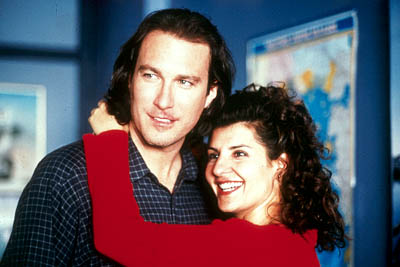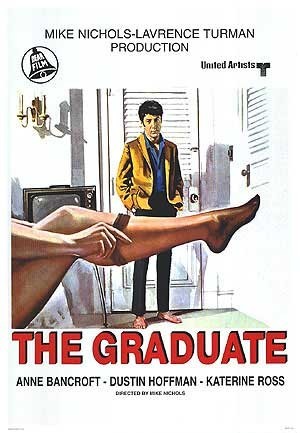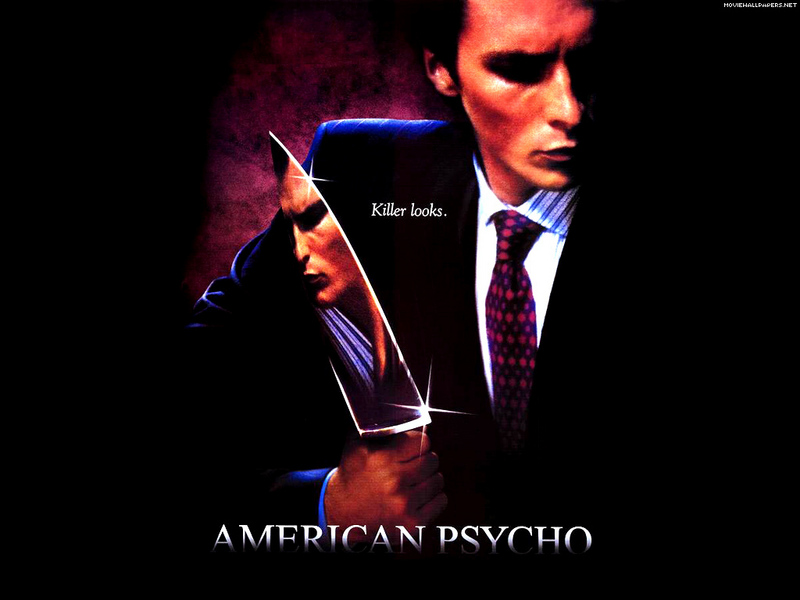Professor Wexler
English 313 Popular Culture
13 December 2010
Identity Crisis and the eventual merging of the dual identity
What does our identity represent? Barker defines identity as, “”A temporary stabilization of meaning or description of ourselves with which we emotionally identify” (Barker 481). This definition would mean that identity is how we think we represent ourselves to the world. In films like The Truman Show, My Big Fat Greek Wedding and American Psycho, each main character of the film represents themselves differently to the world around them, through a political, psychological or comodification. Furthermore, although these characters experience a crisis of their identity at one point, eventually they are able to merge their dual identities.
In Chris Barker’s, Cultural Studies: Theory and Practice," self-identity is defined as “the verbal conceptions we hold about ourselves and our emotional identification with those self-descriptions” (Barker 215). Thus, Anthony Giddens states that self-identity consist the ability to sustain a narrative about the self (Barker 217). The movie, Truman Show, is about a man named Truman Burbank, played by Jim Carrey, who is the star of a hit show called The Truman Show, however, he doesn’t know he is actually on the show. The shows director, Christof, adopted Truman from birth and unknowingly made him the star of this “reality” television shows. His reason for the show is explained by him: “We've become bored with watching actors give us phony emotions. We are tired of pyrotechnics and special effects. While the world he inhabits is, in some respects, counterfeit, there's nothing fake about Truman himself. No scripts, no cue cards. It isn't always Shakespeare, but it's genuine. It's a life.” (The Truman Show). Recording twenty-four/seven of Truman’s life, his identity is perceived by others entirely differently than how he sees himself. Truman essentially lives in a fake world, while believing it is real. In one scene of the film, Christof states, “We accept the reality of the world with which we are presented,” placing Truman’s reality, although not true, is real for Truman and thus, in his world and the real world, he is able to exist with two identities (The Truman Show). In reference to Giddens interpretation of identity, Truman is unable to sustain a narrative about himself as is shown later on in the film.
Within the Marxist subject, it is argued that what is to be a person cannot be universal (Barker 221). Instead, our identities are a social formation of a definite time and place with specific characteristics. In response, The Truman Show’s basic theme; that all love Truman because they relate to him in some way, would thus be considered condemned by Marxist notions, and instead, a social representation would be deemed correct.
Eventually, Truman has an identity crisis after finding out his “father” in actuality is “still alive.” As Truman continues on with his life, he notices small details that suggest something was odd about his life. Then at the climax of the movie, after his father had supposedly drowned in the ocean, he meets his father. This event could be considered very traumatizing to himself and his identity. This dramatic event caused him to doubt everything he considered to be true in his life. Thus, he had an identity crisis, that led him to finally discover the truth about his “life.” When he finally leaves his fake world, he is to realize the difference between reality and fantasy. His two identities formed from broadcasting and from himself are melded into one as he can finally “stabilize” a meaning for himself that he can relate through to real emotions like love.
Romantic movies also have characters where their identities are conflicted. In "Material Girl': The Effacements of Postmodern Culture," Susan Bordo argues that,
"we are surrounded by homogenizing and normalizing images- images whose content is far from arbitrary, but instead suffused with the dominance of gendered, racial, class and other cultural iconography" (1101).
In My Big Fat Greek Wedding, the main character of the film, Toula Portokalos essentially goes through an identity crisis throughout the film. Form a young age, she watched the world through two sides; the American and the Greek. One scene of the movie that exemplifies Bordo’s argument that these “homogenizing and normalizing images,” essentially create our identity, occurs early on in the film. In this scene, she is shown as a little girl at school during lunchtime, as she sits down to eat her Moussaka, a group of blonde girls “eating their Wonder Bread sandwiches,” make fun of her for not eating the “normative” type of food that children expect their friends to eat in school (My Big Fat Greek Wedding). Through this ridicule, Toula is conflicted between having her cultural identity, and the American commoditized identify.
Through advertisements, our identities have been turned into a commodity. Bordo adds that, "the very advertisements whose copy speaks of choice and self-determination visually legislate the effacement of individual and cultural difference and circumscribe our choices" (1101). Bordo correlates advertisements to effacement, because essentially, they are the same thing. Ads sell an image that they argue, every "body" needs. Makeup, hair color, clothes, and contacts all "cure," our bodily disorder, thus making our sickly bodies healthy.
Through this effacement, these advertisers are essentially constructing our identity and culture into a distinctive product that can only be achieved through consumption. Our identity is bought by products that will eventually at some point allow us to reach this idealized identity. Humans are no longer individuals, but within a normalized society that accepts a standardized perception of beauty. As it is portrayed through Toula, identity can be bought just through the use of make-up and hair products. After Toula commoditized herself into the American identity that she always wished for, she has essentially ended her “identity crisis,” and has combined her two identities into one.
Through this effacement, these advertisers are essentially constructing our identity and culture into a distinctive product that can only be achieved through consumption. Our identity is bought by products that will eventually at some point allow us to reach this idealized identity. Humans are no longer individuals, but within a normalized society that accepts a standardized perception of beauty. As it is portrayed through Toula, identity can be bought just through the use of make-up and hair products. After Toula commoditized herself into the American identity that she always wished for, she has essentially ended her “identity crisis,” and has combined her two identities into one.
This duality of his identity is something that Pieterse asserts as hybrid identities. Through culture, the concept of hybridity refers to cultural hybridization which distinguishes as a “cultural response, which range from assimilation, through forms of separation, to hybrids that destabilize and blur cultural boundaries. The involves the opening up of ‘imagined communities’ (Barker 257). Thus, a person from two cultures can also have the duality of identities. This hybridity is demonstrated within the film, My Big Fat Greek Wedding, through the division of her identity of her nationality.
Furthermore, Stuart Hall states that cultural identity is not fixed, but a natural sate of being, or a ‘process of becoming,’ (Barker 229). Therefore, each individual’s identity is constantly being discovered. Further, identity is a ‘production,’ which is shifting and fragmenting identities (Barker 229). Thus, each person is a different identity in different environments where each place creates a specific identity is made for that situation.
This ‘fragmented,’ identity is especially evident in the thriller movies, American Psycho. The main characters dilemma of his identity is very clearly recognized through his narration. Patrick Bateman played by Christian Bale, declares while peeling off a face mask,
"There is an idea of Patrick Bateman; some kind of abstraction. But there is no real me: only an entity, something illusory. And though I can hide my cold gaze, and you can shake my hand and feel flesh gripping yours and maybe you can even sense our lifestyles are probably comparable... I simply am not there."
"There is an idea of Patrick Bateman; some kind of abstraction. But there is no real me: only an entity, something illusory. And though I can hide my cold gaze, and you can shake my hand and feel flesh gripping yours and maybe you can even sense our lifestyles are probably comparable... I simply am not there."
This statement of being "simply not there," essentially removes his identity. He is not able to answer the questions presented by Giddens, or at least, truthfully, “What to do? How to act? Who to be?” (Barker 217). How he acts and who he is does not actually represent him. Humans are essentially mimetic, which means that most of us are not able to answer the question, of “Who to be?” Through mimesis, we are not able to adopt our own identity, but of someone else’s, essentially creating a cyclical process that results in the absence of originality.
Bateman’s statement that he is an illusion relates to Freud’s psychoanalytic theory on the self. Because the self is fractured into the ego, superego, and unconscious, the self is then a unified narrative of the self that is acquired over time through the symbolic order of language and culture and (Barker 222). Thus, he concludes that through “the process of identification with others and with social discourse we create an identity that embodies an illusion of wholeness” (Barker 222). This is essentially the identity of Bateman and the persona he creates with the people he socializes with. Through the use of language and culture, Bateman has create an identity that may seem complete and whole externally, he is in actuality a hollow shell that is “simply not there” (American Psycho).
Giddens goes on to say that “identity is not a collection of traits that we posses. Identity is not something we have, nor an entity or a thing to which we can point. Rather, identity is a mode of thinking about ourselves” (Barker 217). Thus, he is an illusion, unable to think for himself. Bateman is essentially all exterior; a composite of many things, where none of them are truly him.
This quote, stated in Barker, wholly defines the climax of Bateman’s identity crisis, "Identity is best understood not as a fixed entity but as an emotionally charged discursive description of ourselves that is subject to change" (Barker 216). After Bateman’s unceasing murderous rampage, he finally reaches the moment of crisis in realizing what he was actually doing. During Bateman’s phone call to his friend, he displays his true identity versus the false one he was portraying throughout the film. Here, he allows himself to merge his two identities as he finally realizes his actions and returns back to his old routine.
It is stated in Barker that in the postmodern sense, "the decentred or postmodern self involves the subject in shifting, fragmented and multiple identities. Persons are composed not of one but of several, sometimes contradictory, identities" (220). Thus, depending on where one is placed, a person usually has two maybe more, identities in this world. If a person is a school, church, shopping or the movies, they are one identity completely different than at home. Who a person is with also adds to the complexity of identities a person can create to assimilate with the environment. The characters of these films all have this duality of identity, that eventually, they realize their “crisis” of identity, and revert back to the normality of life.
Works Cited
American Psycho. Dir. Mary Harron. Perf. Christian Bale. Universal Studios, 2000.
DVD.
Barker, Chris. Cultural Studies Theory and Practice. 3rd ed. London: Sage
Publications, 2008.Print.
Bordo, Susan. "'Material Girl': The Effacements of Postmodern Culture."
My Big Fat Greek Wedding. Dir. Joel Zwick. By Nia Vardalos. IFC Films, 2002
The Truman Show. Perf. Jim Carrey. Paramount Pictures, 1998.













He argues that we are flawed because of our love of idealizing love. Humans basically glorify and externalize what they see to achieve a form of love that is highly unrealistic. This type of love I perceive as a form of infatuation which can be found within our highly materialized society where people like celebrities or politicians are idolized. This delusional, infatuated love can essentially be evil because it blinds society into exalting a specific physical image and leads into a destructive, imbalanced and irrational society.
Furthermore, I believe he is also arguing that when someone states, "I love you," that person is sharing a sentiment that it is presently happening now but though it is attempted, it is not eternal.
When viewed within a world perspective, this statement can also be equated to political relations. For example, two countries may announce that they are at the moment in alliance, but it is not always constant for there is always an awareness of impending violence. When one states, "I love you," it is fixed upon the present, bounded within time. However, there it always that impending moment that those sentiments may be reversed, and may enact the opposite that is love, which is evil. Hence our existence is always imbalanced.